
Aeschynanthus is a genus of about 150 species of evergreen subtropical and tropical plants in the family Gesneriaceae. They are usually trailing epiphytes with brightly colored flowers that are pollinated by sunbirds. The genus name comes from a contraction of aischuno and anthos (flower). The common name for some species is lipstick plant, which comes from the appearance of the developing buds emerging from the calyces. A full list of the accepted species and their synonyms can be found in the Smithsonian Institution's World Checklist of Gesneriaceae.

Sterculia is a genus of flowering plants in the mallow family, Malvaceae: subfamily Sterculioideae. Members of the genus are colloquially known as tropical chestnuts. Sterculia may be monoecious or dioecious, and its flowers unisexual or bisexual.
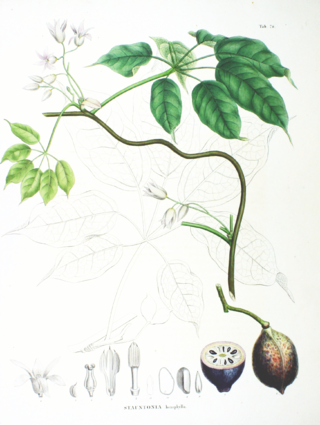
Stauntonia is a genus of flowering plants in the family Lardizabalaceae. It is named after George Staunton, who brought it to Britain from China in the 19th century.

Tetrastigma is a genus of plants in the grape family, Vitaceae. The plants are lianas that climb with tendrils and have palmately compound leaves. Plants are dioecious, with separate male and female plants; female flowers are characterized by their four-lobed stigmas. The species are found in subtropical and tropical regions of Asia, Malaysia, and Australia, where they grow in primary rainforest, gallery forest and monsoon forest and moister woodland. Species of this genus are notable as being the sole hosts of parasitic plants in the family Rafflesiaceae, one of which, Rafflesia arnoldii, produces the largest single flower in the world. Tetrastigma is the donor species for horizontal gene transfer to Sapria and Rafflesia due to multiple gene theft events.
Dischidia is a genus of plants in the “dog-bane” family Apocynaceae, collectively known as the “milkweeds”. They are epiphytes, native to tropical areas of China, India as well as Bhutan’s southern borders, wherever minimal frost occurs. Additionally, they are known from most areas of Mainland Southeast Asia, including forested areas of Myanmar, Thailand, Vietnam, Cambodia, Laos, and some parts of Indonesia, Malaysia and Singapore. Several species are also native to Papua New Guinea and northeastern Australia.
Imbralyx incredibilis, synonym Fordia incredibilis, is a species of legume in the family Fabaceae. It is a tree endemic to Peninsular Malaysia. It is threatened by habitat loss.

Anodendron is a genus of plant in the family Apocynaceae first described as a genus in 1844. It is native to most of tropical Asia: China, the Indian subcontinent, Southeast Asia, New Guinea, and some islands of the western Pacific.

Capparis is a genus of flowering plants in the family Capparaceae. It includes 142 species of shrubs or lianas which are collectively known as caper shrubs or caperbushes. Capparis species occur over a wide range of habitat in the subtropical and tropical regions of Africa, Eurasia, Australasia, and the Pacific.

Hopea is a genus of plants in the family Dipterocarpaceae. It contains some 113 species, distributed from Sri Lanka and southern India to the Andaman Islands, Myanmar, southern China, and southward throughout Malesia to New Guinea. They are mainly main and subcanopy trees of lowland rainforest, but some species can become also emergent trees, such as Hopea nutans.
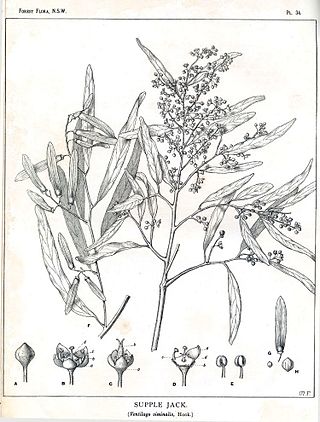
Ventilago is a genus of plants in the family Rhamnaceae. It includes about 40 species found in the tropics of South and SE Asia, Australasia, with one species each in Africa and Madagascar.

Smythea is a genus of plants in the family Rhamnaceae. It includes eleven species found in southeast Asia and Polynesia.
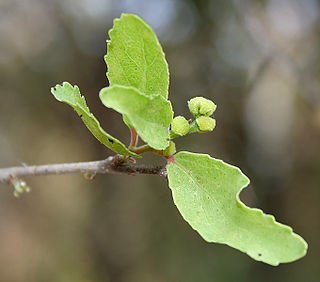
Flacourtia is a genus of flowering plants in the family Salicaceae. It was previously placed in the now defunct family Flacourtiaceae. The generic name honors Étienne de Flacourt (1607–1660), a governor of Madagascar. It contains 23 species of shrubs and small trees that are native to the African and Asian tropics and subtropics. Several species, especially Flacourtia indica, are cultivated as ornamentals and for their fruits. The trunks of small trees are often guarded by branching spines.
Hedyotis (starviolet) is a genus of flowering plants in the family Rubiaceae. Many species of this genus such as Hedyotis biflora, H. corymbosa and H. diffusa are well known medicinal plants. Hedyotis is native to tropical and subtropical Asia and to islands of the northwest Pacific. It comprises about 115 species. The type species for the genus is Hedyotis fruticosa.
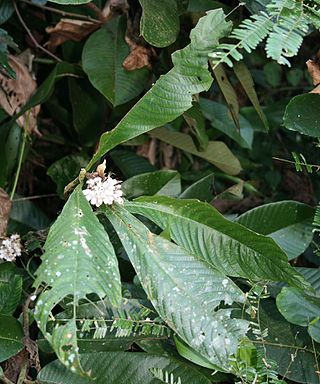
Mycetia is a genus of flowering plants in the family Rubiaceae. It includes 54 species, ranging from the Indian subcontinent through Indochina, southern China, and Malesia to New Guinea.

Antidesma montanum is a species of tree in the family Phyllanthaceae, native to Southeast Asia, from India to the Philippines. It can grow up to 10 m (33 ft). The fruits are edible. Four varieties have been accepted, each of which has multiple synonyms, which include Antidesma obliquinervium for A. montanum var. montanum.
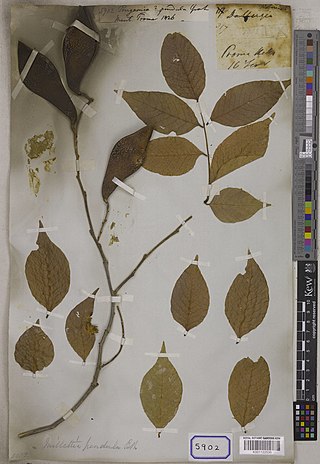
Imbralyx is a genus of flowering plant in the family Fabaceae, native from Bangladesh and south-central China to Sumatra. The genus was established by Robert Geesink in 1984.

Damrongia is a genus of flowering plants in the Gesneriad family, centered in Thailand and found in southern China, Southeast Asia, and Sumatra. Species were reassigned to it in 2016 in a revision of Loxocarpinae.
Cyrtandromoea is a genus of flowering plants belonging to the family Phrymaceae. For a considerable time, the family placement of the genus remained uncertain; it was placed in either Gesneriaceae or Scrophulariaceae. A molecular phylogenetic study published in 2019 showed that it belonged in Phrymaceae.
Hymenandra is a genus of flowering plants belonging to the family Primulaceae.
Phacellaria is a genus of flowering plants belonging to the family Santalaceae.













